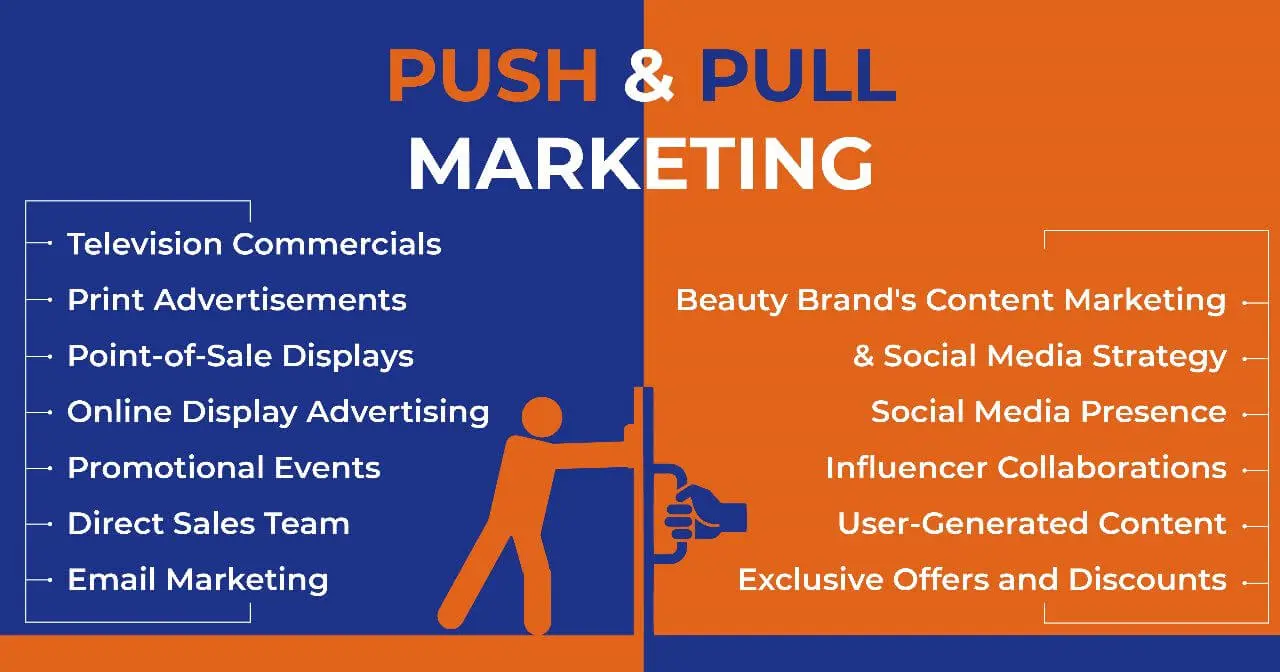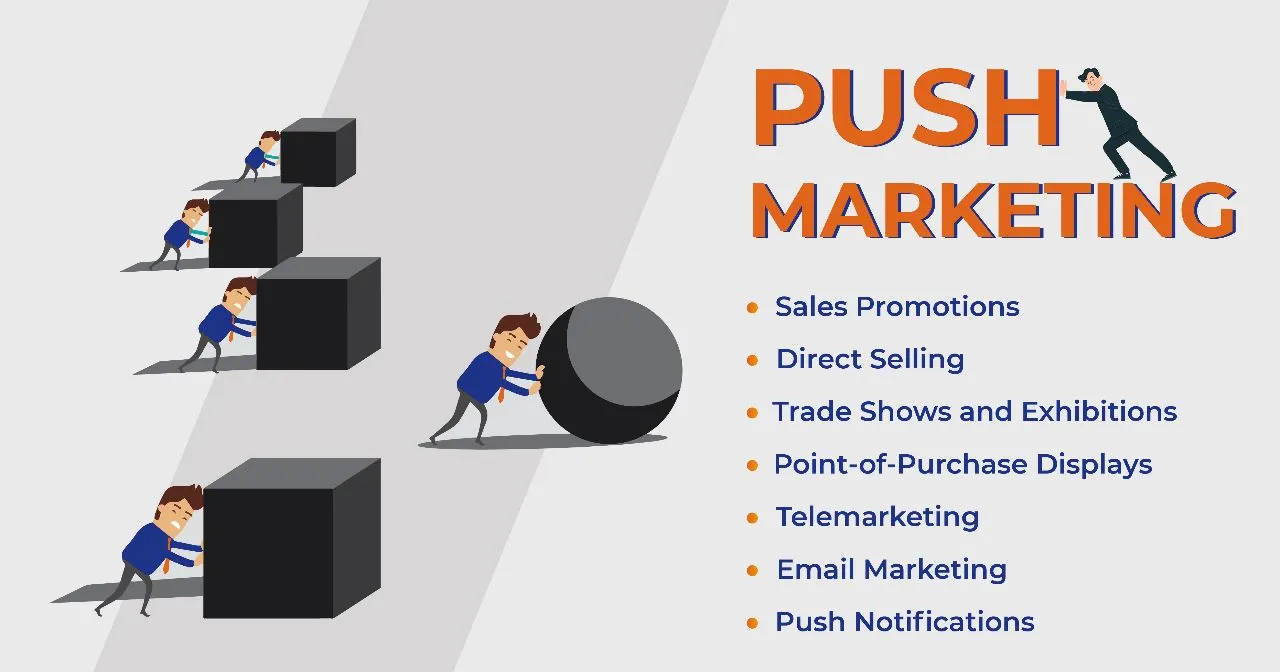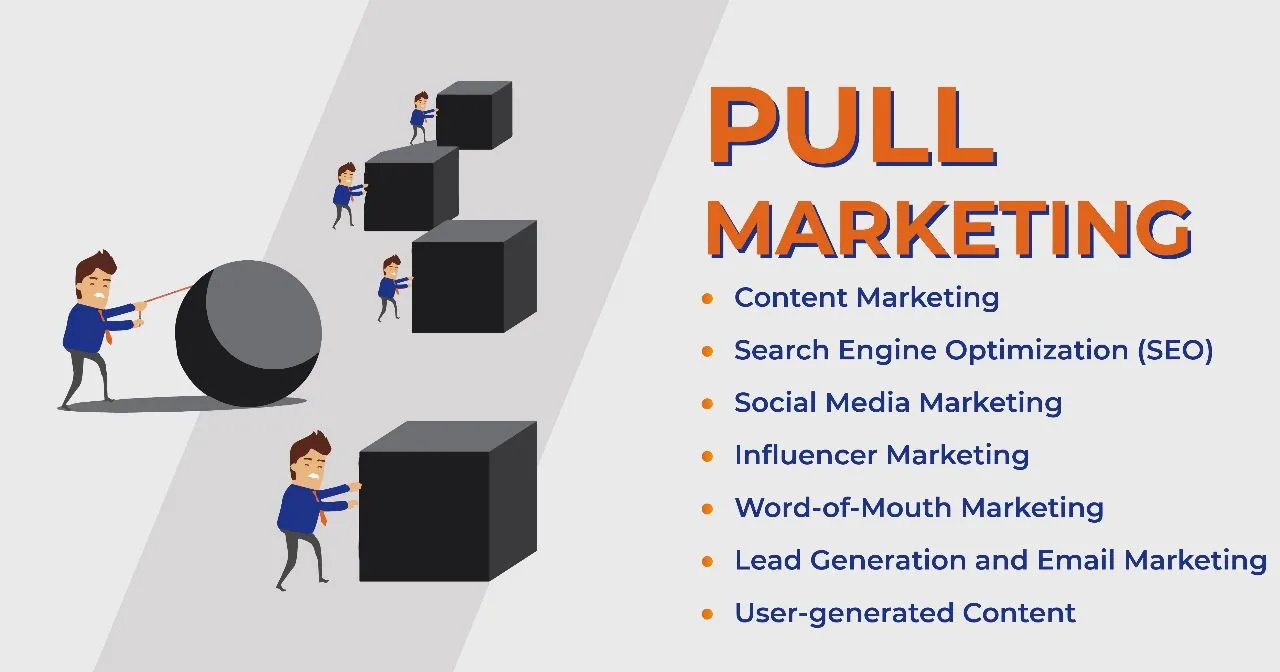Push-Pull Marketing: A Step-by-Step Guide to Developing Your Strategy

Push-Pull Marketing: A Step-by-Step Guide to Developing Your Strategy
Businesses may use a combination of push-and-pull marketing strategies to create a well-rounded approach to their marketing efforts. Through proactive promotional tactics, push marketing helps create immediate awareness, generate quick sales, and reach a wide audience. On the other hand, pull marketing aims to attract and engage potential customers by providing valuable content and experiences, fostering long-term relationships and customer loyalty. By utilizing both strategies, businesses can maximize their reach, generate immediate sales, and build lasting connections with their target audience. Let's understand Push Pull in detail.

What is Push Marketing
Push marketing is a promotional strategy in which businesses actively promote their products or services to their intended audience. It involves proactively reaching out to potential customers and persuading them to purchase or take a specific action. In push marketing, the company takes the initiative to deliver its message and offerings to the consumer.
The critical characteristic of push marketing is its proactive nature. Instead of waiting for customers to seek out their products or services, businesses employing push marketing techniques proactively promote and distribute their offerings. This approach is often associated with traditional advertising channels such as TV commercials, radio ads, print advertisements, direct mail, and telemarketing.
Push marketing relies on interrupting the consumer's attention to deliver its message. It aims to capture the target audience's interest and influence their purchasing decisions through repeated exposure and persuasive messaging. The goal is to create brand awareness, generate leads, and stimulate immediate sales.
Push marketing employs various methods and tactics, such as:
Advertising is placing ads in various media outlets such as print, television, radio, or online platforms to reach a large audience.
Sales Promotions: Offering discounts, limited-time deals, coupons, or incentives to entice consumers to purchase.
Direct Selling: Sales representatives actively approach potential customers to promote and sell products or services.
Trade Shows and Exhibitions: Participating in industry events showcasing products, networking, and attracting potential customers.
Point-of-Purchase Displays: Utilizing attractive displays and promotions at the point of sale to grab customers' attention.
Telemarketing: involves contacting potential customers without prior invitation and offering them products or services directly.
Email Marketing: Sending promotional emails to targeted recipients to generate interest and drive sales.
Push Notifications: Utilizing mobile apps or web browsers to send timely messages and offers to customers' devices.
While push marketing can effectively reach a broad audience and create initial awareness, it is often associated with a more interruptive and one-way communication style. In addition, consumers may perceive push marketing efforts as intrusive, especially when they are irrelevant or personalized to their needs. Businesses must take great care in their decision-making. balance push marketing with other customer-centric strategies and respect consumers' preferences and privacy.
Ultimately, push marketing is about proactively making the company's message and offerings to potential customers to drive immediate action and generate sales.

What is Pull Marketing
Pull marketing, or inbound marketing, is a promotional strategy focused on attracting and engaging potential customers by creating valuable content and experiences. Rather than actively pushing products or services onto the audience, pull marketing aims to naturally draw customers towards the brand through relevant and compelling content.
The core principle of pull marketing is to provide value and establish a connection with the target audience, cultivating their interest and trust. By offering valuable information, educational resources, entertainment, or solving their problems, businesses aim to position themselves as reliable and knowledgeable sources within their industry.
In pull marketing, the emphasis is on building brand awareness and credibility and establishing a robust online presence.
Here are some key elements and strategies commonly used in pull marketing:
Content Marketing: An effective way to connect with your audience is by producing and sharing informative content such as blog posts, articles, videos, infographics, podcasts, and social media posts that are relevant to your target audience. The content is designed to provide information, solve problems, entertain, or inspire, aiming to attract and engage potential customers.
Search Engine Optimization (SEO): Optimizing website content to improve its visibility in search engine results. By incorporating relevant keywords and meta tags and optimizing site structure, businesses can increase organic traffic and attract interested prospects actively searching for information related to their industry.
Social Media Marketing: Leveraging all social media platforms to build a community, share content, engage with followers, and amplify brand awareness. Businesses use social media to interact directly with potential customers, share valuable content, run contests or promotions, and foster relationships.
Influencer Marketing: Collaborating with influencers or industry experts with a significant following and influence within a particular niche. These influencers can help amplify the brand's message and reach a broader audience that may be interested in the products or services offered.
Word-of-Mouth Marketing: Encouraging satisfied customers to spread positive reviews, testimonials, and recommendations about the brand. One way to make it easier is by using online reviews, referral programs, and sharing on social media.
Lead Generation and Email Marketing: Creating compelling offers or gated content requiring visitors to provide contact information. By capturing leads, businesses can nurture these prospects through targeted email campaigns, providing additional valuable content and eventually converting them into customers.
User-generated Content: We encourage customers to create and share. Their content is related to the brand, such as reviews, testimonials, or social media posts. This helps build social proof and authenticity and encourages others to engage with the brand.
The critical objective of pull marketing is to establish a strong brand presence, attract the right audience, and cultivate long-term relationships. By offering value, addressing customer needs, and creating engaging experiences, businesses can naturally draw customers towards their brand, leading to increased customer loyalty, conversions, and brand advocacy.
It's important to note that pull marketing doesn't exclude all traditional advertising and promotion. Instead, it simply focuses on creating meaningful interactions and providing value to the audience rather than solely relying on interruptive and intrusive advertising techniques.
When to use push marketing
Push marketing is a good option for businesses trying to reach a broad audience quickly. It is also effective for companies launching new products or services. However, push marketing can be expensive, and it can be challenging to target your audience effectively.
Pros of push marketing:
- Reaches a broad audience quickly
- Effective for launching new products or services
- It can be used to generate short-term sales
Cons of push marketing:
- Expensive
- It can be challenging to target your audience effectively
- It may not be effective for building long-term relationships with customers
Examples of companies that have successfully used push marketing:
- Coca-Cola: Coca-Cola has used push marketing to promote its products through television commercials, billboards, and other traditional advertising channels.
- Nike: Nike has used push marketing to promote its products through celebrity endorsements and sports sponsorships.
When to use pull marketing
Pull marketing is a good option for businesses trying to build brand awareness and loyalty. It is also effective for businesses targeting a specific niche market. However, pull marketing can take time to see results.
Pros of pull marketing:
- Builds brand awareness and loyalty
- Effective for targeting a specific niche market
- It can be used to generate long-term sales
Cons of pull marketing:
- It takes time to see the results
- It may not be effective for generating short-term sales
Examples of businesses that have successfully used pull marketing:
Strategies Involved in Push and Pull Marketing
Push and pull marketing strategies involve different approaches to promote products or services. Let's delve into each strategy and provide detailed examples:
Push Marketing Strategy: Push marketing involves proactively pushing products or services directly to the target audience. The goal is to create immediate awareness and stimulate demand. Here are some strategies commonly used in push marketing:
a) Advertising: Traditional advertising channels like television, radio, print media, or online display ads are used to reach a broad audience. For example, a soft drink company may run TV commercials during popular shows to create awareness and encourage immediate purchases.
b) Sales Promotions: Limited-time discounts, buy-one-get-one offers, or coupons are employed to entice customers to buy quickly. An example is a retail store offering a 50% discount on selected items for a weekend sale.
c) Direct Selling: Sales representatives engage directly with potential customers to pitch products or services. This can include door-to-door sales, telemarketing, or in-person demonstrations. For instance, a cosmetics company may send representatives to offer product samples and demonstrate their new line of skin care products to potential customers.
d) Trade Shows and Exhibitions: Participating in industry-specific events and exhibitions to showcase products or services. Companies set up booths or displays to attract attendees and generate leads.
Example: Mobile Phone Manufacturer's Push Marketing Strategy
The mobile phone manufacturer uses a push marketing strategy to promote and sell its latest smartphone model. Here's how they execute their push marketing strategy:
Television Commercials: The manufacturer creates compelling television commercials that showcase their new smartphone's features, design, and capabilities. These ads are strategically aired during popular TV shows, sports events, and prime time slots to capture the attention of a broad audience.
Print Advertisements: The manufacturer places full-page advertisements in popular magazines and newspapers with a wide readership. These ads highlight the smartphone's essential features and specifications and offer promotional pricing or special bundle deals.
Point-of-Sale Displays: The manufacturer collaborates with retail stores to set up eye-catching displays showcasing their new smartphone. These displays are strategically placed near the entrance or in high-traffic areas to attract customer's attention and encourage them to explore the product.
Online Display Advertising: The manufacturer utilizes online display advertising on popular websites, social media platforms, and mobile apps. They create visually appealing banner ads that feature the smartphone's design and highlight its unique selling points, targeting users interested in smartphones or technology-related content.
Promotional Events: The manufacturer organizes promotional events with retail stores or mobile network providers. These events feature live demonstrations of the smartphone's features, interactive experiences, and exclusive discounts or gifts for customers who purchase the device on the spot.
Direct Sales Team: The manufacturer employs a team of sales representatives who actively approach potential customers at malls, trade shows, or public spaces. They engage in face-to-face conversations, provide product demonstrations, and offer special incentives to encourage immediate purchases.
Email Marketing: The manufacturer sends targeted email campaigns to their existing customers and subscribers, informing them about the new smartphone launch. The emails highlight the smartphone's key features and exclusive offers and provide a direct link to purchase the device.
By implementing this push marketing strategy, the mobile phone manufacturer aims to create immediate awareness and generate sales for their new smartphone model. The strategic placement of television commercials, print advertisements, point-of-sale displays, and targeted online advertising helps reach a broad audience and capture their attention. In addition, the promotional events and direct sales team enable face-to-face interactions, allowing potential customers to experience the smartphone firsthand and make a purchase decision on the spot. The email marketing campaigns also serve as a direct channel to inform existing customers and subscribers about the new product, encouraging repeat purchases and brand loyalty.
Pull Marketing Strategy: Pull marketing focuses on attracting and engaging potential customers by providing valuable content and experiences. The goal is to connect with the audience, build trust, and naturally draw them towards the brand. Here are some strategies commonly used in pull marketing:
a) Content Marketing: Creating relevant and valuable content like blog posts, videos, podcasts, or guides that address customer needs or interests. For instance, a fitness equipment brand may publish blog articles on workout tips, healthy recipes, and video tutorials to engage fitness enthusiasts.
b) Search Engine Optimization (SEO): Improving the visibility of website content in search engine results through optimization. By incorporating relevant keywords, creating informative blog posts, and optimizing site structure, businesses attract organic traffic from users actively searching for related information. An example is an e-commerce store optimizing its product pages and blog content to appear higher in search results for relevant keywords.
c) Social Media Marketing: Leveraging social media platforms to build a community, share valuable content, and engage with followers. Brands create engaging posts, run contests or promotions, and respond to customer inquiries. For example, a fashion brand may use Instagram to showcase new collections and collaborate with influencers; to interact with your followers, simply respond to their comments and direct messages.
d) Word-of-Mouth Marketing: Encouraging satisfied customers to share positive reviews, testimonials, and recommendations about the brand. This can be facilitated through online reviews, referral programs, or social media sharing. For instance, a restaurant may incentivise customers to leave reviews on popular review platforms or offer discounts for referring friends.
It's worth noting that push-and-pull marketing strategies are not mutually exclusive. Successful marketing campaigns integrate elements from both strategies to achieve the desired results. The key is to strike a balance based on the target audience, industry, and specific marketing objectives.
Example: Beauty Brand's Content Marketing and Social Media Strategy
The beauty brand focuses on creating valuable content and engaging with its target audience through social media platforms. Here's how they execute their pull marketing strategy:
Content Creation: The brand regularly produces informative and engaging content related to skincare, makeup, and beauty trends. They create blog articles, video tutorials, and infographics that provide tips, product recommendations, and step-by-step guides for their audience.
Search Engine Optimization (SEO): The brand optimizes its website and blog content with relevant keywords related to beauty and skincare. By doing so, they improve their organic search rankings and increase the chances of attracting users actively seeking beauty-related information.
Social Media Presence: The company is well-represented on all social media platforms such as Instagram, YouTube, and TikTok. They regularly share visually appealing images, videos, and tutorials showcasing their products and demonstrating different beauty techniques.
Engaging with Followers: The brand actively engages with their followers by responding to comments, direct messages, and inquiries. They provide personalized advice, answer questions, and offer recommendations based on individual needs.
Influencer Collaborations: The brand partners with popular beauty influencers who have a strong following and influence within the target market. These influencers create content featuring the brand's products, share their experiences, and provide honest reviews to their followers.
User-Generated Content: The brand encourages its customers to share their experiences, beauty routines, and product reviews on social media platforms. They may run contests or offer incentives for customers who share their content and tag the brand.
Exclusive Offers and Discounts: The brand occasionally provides exclusive offers, discounts, or free samples to its social media followers and newsletter subscribers. This incentivizes potential customers to engage with the brand and consider purchasing.
By implementing this pull marketing strategy, the beauty brand aims to establish itself as an authoritative source of beauty information, build trust among its audience, and naturally draw customers towards its products. Through valuable content, active engagement on social media, and influencer collaborations, they create a community of loyal followers who are more likely to purchase their products and recommend them to others.

Blog Admin:
Ravinder Bharti
CEO & Founder - Public Media Solution
About: Ravinder Bharti is the Founder and CEO of Public Media Solution,
a leading
marketing, PR, and branding company based in India.